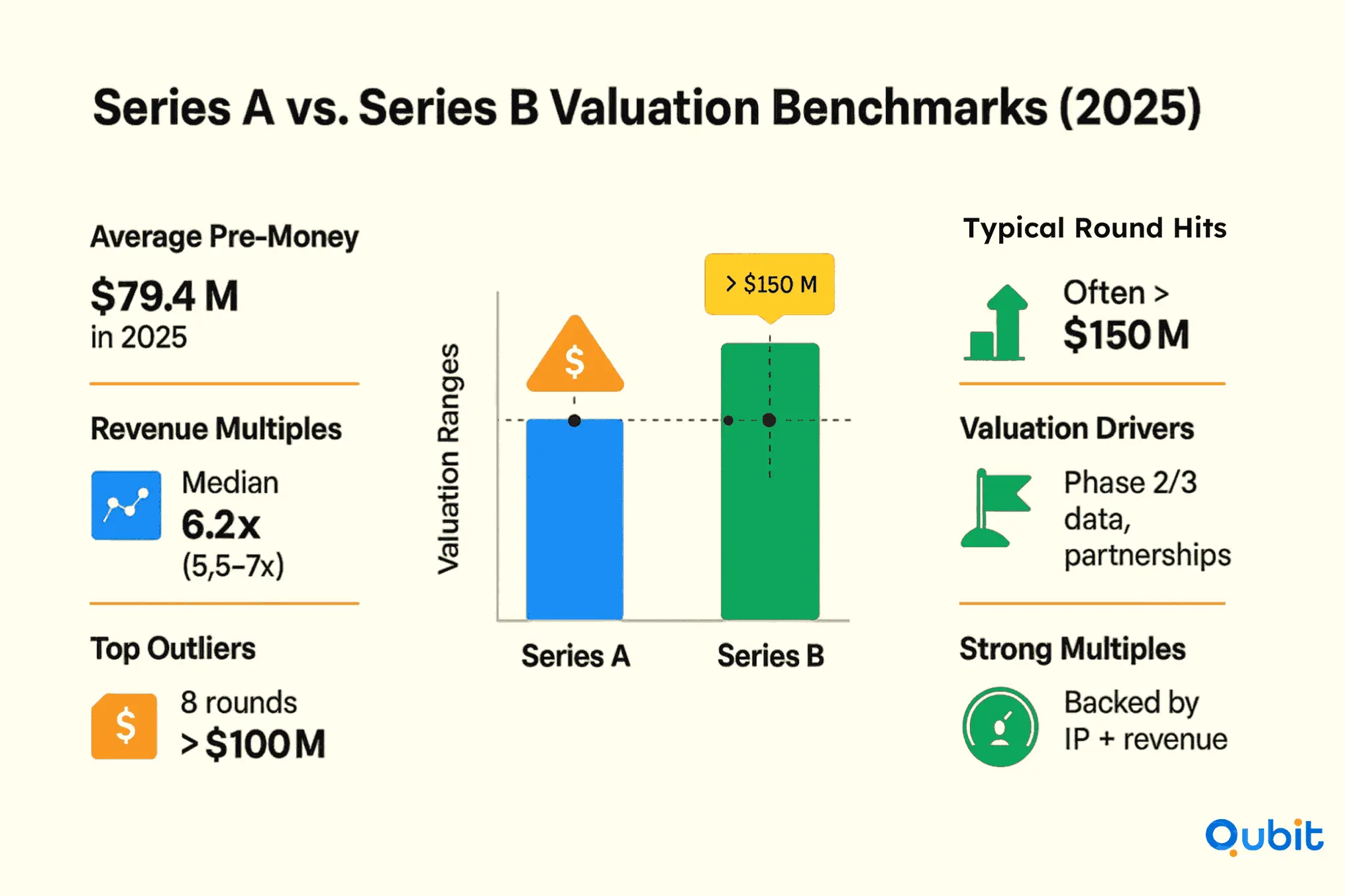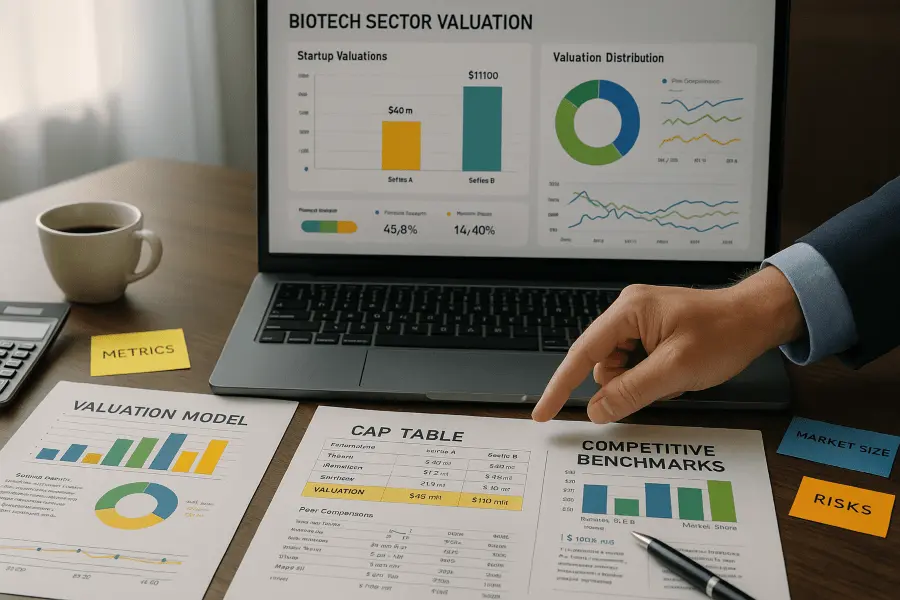Valuation benchmarks play a pivotal role in shaping the trajectory of biotech startups during Series A and B funding rounds. These metrics not only determine the financial worth of a company but also influence investor confidence and long-term growth strategies. Biotech valuation benchmarks are unique, often driven by factors such as scientific milestones, regulatory pathways, and market potential rather than immediate revenue generation.
The discussion gains a broader context when you explore biotech startup fundraising strategies, which detail early-stage funding approaches that complement valuation benchmarks. Understanding these benchmarks is essential for founders and investors alike, as they navigate the complexities of biotech funding rounds.
In the sections ahead, we’ll delve into the nuances of Series A and B valuations, highlighting key trends and challenges specific to the biotech industry.
Biotech Industry Overview and Valuation
Biotech valuations stand apart from traditional industries due to their unique characteristics. Unlike sectors with predictable revenue streams, biotech companies face extended development timelines, scientific uncertainties, and regulatory hurdles. These factors demand specialized valuation methods tailored to the industry's complexities.
Why Biotech Valuations Are Unique
Biotech companies often operate without immediate revenue, relying instead on future projections tied to product approvals and market entry. This reliance introduces heightened risk, as scientific breakthroughs and regulatory approvals are unpredictable. Additionally, the capital-intensive nature of drug development means that financial projections in biotech must account for years of investment before profitability.
Specialized Valuation Methods
To address these challenges, biotech valuations frequently utilize methods such as revenue multiples, EBITDA multiples, and Discounted Cash Flow (DCF) analysis. For example, a Discounted Cash Flow (DCF) Analysis is particularly effective in evaluating long-term potential, as it accounts for future cash flows discounted to their present value. Similarly, tools like the 2025 Biotech Valuation Multiples Database enable startups to benchmark their performance against industry standards, ensuring alignment with market expectations.

Series A Valuation Benchmarks
In 2025, Series A pre-money valuations for biotech startups have averaged around $79.4 million. This figure shows a steady increase from previous years, reflecting ongoing investor interest despite recent market volatility. Some Series A rounds have been exceptionally large, with eight deals exceeding $100 million and several more topping $80 million in the first half of 2025. These outliers are often driven by strong lead investors and high-profile technology, such as artificial intelligence in drug discovery.
The median revenue multiple for biotech and genomics companies at this stage is about 6.2x, with a range typically between 5.5x and 7x. These multiples are influenced by the company’s pipeline, regulatory progress, and the perceived probability of clinical success. For example, companies advancing from Phase 2 to Phase 3 trials often see a significant jump in valuation as investor confidence grows.
Series B Valuation Benchmarks
Series B valuations build on the foundation set in Series A, with higher expectations for clinical progress and risk reduction. In 2025, the trend is toward larger rounds and higher valuations for companies that can demonstrate clear milestones. Investors are increasingly favoring startups with strong clinical data, regulatory clarity, and partnerships that validate the business model.
Valuations at Series B are shaped by several factors:
- Advancement in clinical trials, especially positive Phase 2 or early Phase 3 data.
- Strong intellectual property and a diversified pipeline.
- Strategic partnerships with pharmaceutical companies or research institutions.
- Revenue potential based on market size and competitive landscape.
While exact Series B valuation averages are less frequently published, successful rounds in 2025 have often exceeded $150 million for companies with compelling data and partnerships. The revenue multiples for these later-stage startups remain robust, reflecting the industry’s appetite for innovation and the high costs associated with drug development.
Key Drivers of Biotech Valuations
Regulatory Approvals and Pipeline Success
Regulatory milestones are the biggest catalysts for biotech valuations. FDA or EMA approvals can transform a pre-revenue company into a billion-dollar business overnight. Conversely, setbacks in clinical trials can lead to sharp valuation declines. Companies with multiple assets in development are valued higher due to diversified risk and more opportunities for success.
Market Conditions and Investor Sentiment
The macroeconomic environment in 2025 is challenging, with high interest rates and cautious investor sentiment. Despite this, the biotech sector continues to attract significant capital, especially for startups with clear paths to revenue and strong fundamentals. Investors are prioritizing companies that can demonstrate cash efficiency and readiness for market shifts.
Sector and Niche Differences
Biotech is not a single market. Valuations differ across segments such as therapeutics, diagnostics, and genomics. Therapeutics companies, especially those developing novel drugs, command the highest multiples due to the potential for blockbuster products and patent protection. Genomics and AI-driven biotech startups are also seeing premium valuations, reflecting their growing impact on healthcare innovation.
Practical Advice for Founders
- Prepare Detailed Financials: Investors expect clear, audited financial statements and a transparent use of funds.
- Highlight Clinical Milestones: Emphasize progress in trials and regulatory achievements to justify higher valuations.
- Build Strategic Partnerships: Collaborations with pharma companies or research institutions can significantly boost credibility and valuation.
- Focus on Data Quality: Robust and reproducible data is essential for attracting top-tier investors and securing favorable terms.
- Understand Your Niche: Tailor your pitch and valuation expectations to your specific biotech segment, as risk and reward profiles vary widely.
Conclusion
Securing Series A and B funding requires a blend of strategic planning and precise execution. Startups must prioritize specialized valuation methods tailored to their industry while maintaining transparency in financial projections. Equally important is aligning scientific milestones with investor expectations, ensuring that progress resonates with the goals of potential backers.
As you prepare for your next funding round, focus on refining your pitch, showcasing measurable achievements, and demonstrating a clear path to scalability. These steps not only build investor confidence but also position your startup for sustainable growth.
If you're gearing up for your next funding round, we at Qubit Capital offer Fundraising Assistance to help secure the capital you need. Let us guide you through the complexities of Series A and B funding to achieve your business goals.
Key Takeaways
- Biotech valuations rely on unique metrics including clinical milestones and regulatory risk.
- Specialized methods like revenue multiples, EBITDA multiples, and DCF analysis are essential.
- VC funding in biotech is increasingly selective with longer due diligence cycles.
- Strategic partnerships and clear financial projections are critical for startups.
- Up-to-date Q1 2025 data underscores the importance of aligning investor expectations with scientific progress.
Frequently asked Questions
What are Series A valuation benchmarks for biotech startups?
Series A valuation benchmarks for biotech startups typically integrate projections based on clinical milestones, R&D progress, and potential market impact.


 Back
Back



